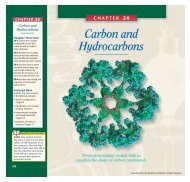You also want an ePaper? Increase the reach of your titles
YUMPU automatically turns print PDFs into web optimized ePapers that Google loves.
SECTION 9-3<br />
Classroom Practice<br />
The following may be used<br />
as teamwork exercises or for<br />
demonstration at the chalkboard<br />
or on an overhead projector.<br />
PROBLEM<br />
Bernoulli’s equation<br />
A camper creates a shower by<br />
attaching a tube to the bottom of a<br />
hanging bucket that is open to the<br />
atmosphere on top. If the water<br />
level in the tank is 3.15 m above<br />
the end of the tube (the shower<br />
head), then what is the speed of<br />
the water exiting the tube?<br />
Answer<br />
7.86 m/s<br />
A pipe narrows from a cross<br />
section of 2.0 m 2 to 0.30 m 2 .If<br />
the speed of the water flowing<br />
through the wider area of the<br />
pipe is 8.0 m/s, what is the speed<br />
of the water flowing through the<br />
narrow part?<br />
Answer<br />
53 m/s<br />
Assuming incompressible flow,<br />
what is the change in pressure as<br />
the pipe narrows?<br />
Answer<br />
1.4 × 10 6 Pa<br />
336<br />
336<br />
SAMPLE PROBLEM 9D<br />
PROBLEM<br />
SOLUTION<br />
1. DEFINE<br />
2. PLAN<br />
3. CALCULATE<br />
4. EVALUATE<br />
Chapter 9<br />
Bernoulli’s equation<br />
A water tank has a spigot near its bottom. If the top of the tank is open to<br />
the atmosphere, determine the speed at which the water leaves the spigot<br />
when the water level is 0.500 m above the spigot.<br />
Given: h 2 − h 1 = 0.500 m<br />
Unknown: v 1 = ?<br />
Diagram:<br />
2<br />
h2<br />
P2<br />
h1<br />
Choose an equation(s) or situation: Because this problem involves fluid flow<br />
and differences in height, it requires the application of Bernoulli’s equation.<br />
P 1 + ⎯ 1<br />
2 ⎯rv 1 2 + rgh1 = P 2 + ⎯ 1<br />
2 ⎯rv 2 2 + rgh2<br />
Point 1 is at the hole, and point 2 is at the top of the tank. If we assume that the<br />
hole is small, then the water level drops very slowly, so we can assume that v 2 is<br />
approximately zero. Also, note that P 1 = P 0 and P 2 = P 0 because both the top of<br />
the tank and the spigot are open to the atmosphere.<br />
P 0 + ⎯ 1<br />
2 ⎯rv 1 2 + rgh1 = P 0 + rgh 2<br />
Rearrange the equation(s) to isolate the unknown(s):<br />
1<br />
⎯<br />
2 ⎯rv<br />
2<br />
1 = rgh2 − rgh1 v 1 2 = 2g(h2 − h 1)<br />
v1 = 2g (h 2− h 1) <br />
Substitute the values into the equation(s) and solve:<br />
v1 = 2( 9. 81 m/s 2 (0.500 )<br />
v 1 = 3.13 m/s<br />
A quick estimate gives the following:<br />
1<br />
v1 ≈ 2( 10 )(0. 5) ≈ 3<br />
A2<br />
A1<br />
P1<br />
v1<br />
m)<br />
Copyright © by Holt, Rinehart and Winston. All rights reserved.
















